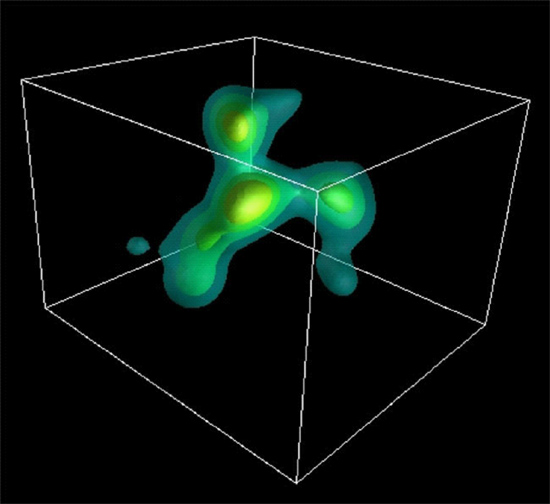A recent
press release from the
European Southern Observatory (ESO)
discusses a vast cloud of gas and
dust originally discovered in 2000,
conventionally measured to be over
300,000 light years in diameter and
over 11 billion light years distant.
Located in the
constellation Aquarius,
the great "blob" is known as LAB-1,
for "Lyman-Alpha Blob 1."
Why the name Lyman-Alpha Blob?
What does Lyman-Alpha mean? Quantum
physics postulates that a hydrogen
atom's electron orbit must abide by
its
principal quantum number.
Mathematical calculations use n = 1
for the smallest orbital radius, n =
2 for the next quantized orbital
step, n = 3, and so on. As
mentioned, those orbital radii must
rise and fall in discrete jumps.
Also, since electrons are
negatively charged, they are
attracted to protons by their
binding energy. Each "n"
orbit's binding energy is expressed
in
electron volts. The
closer to a hydrogen atom's nucleus,
the greater the binding energy. As
an electron jumps down from a higher
binding energy orbit to a lower one,
it emits light in the ultraviolet
range. The photo emissions from the
n2 to n1 jump correspond to 121.6
nanometers. This frequency band is
known as "Lyman-alpha" radiation,
named after
Theodore Lyman.
According to ESO, LAB-1 might be
shining in the 121.6 nanometer
frequency because cool gas is heated
when gravity pulls it toward the
center of the blob. It is also
thought that there might be dynamic
galaxies inside the blob, lighting
it up by their highly energetic
processes: black holes or star
formation, for instance. In a recent
analysis of light coming from LAB-1
the galaxy theory appears to win
out. The polarized light coming from
LAB-1 is the reason that ESO
astronomers have adopted that
theory.
The research team found a ring of
polarized light coming from the
center of the blob. It is not
considered possible for compressed
gas heating up as it falls into the
blob to produce polarized light.
However, if ultraviolet radiation
were emitted from active energy
sources within LAB-1, then the light
would become polarized before it was
scattered by the gas.
One of the principal tenets of
Electric Universe theory is that
electricity flowing through ionized
gas, otherwise known as plasma,
creates long electromagnetic
filaments called Birkeland currents.
Gas obeys the laws of kinetic
motion, with molecules accelerated
by "shock waves" or gravitational
attraction. Plasma behaves according
to the laws of electricity.
According to plasma physicists,
the anisotropy of an
ionized gas polarizes light
shining through it. Polarized
emissions are sometimes used to map
ionized gas and magnetic fields in
discrete sources. Another factor in
the ESO observations that has not
been considered is that some
components of synchrotron radiation
are circularly polarized.
As stated many times in previous
Picture of the Day articles, if
electrons are moving they are called
an electric current. An electric
current in a magnetic field is
defined as “field-aligned" and can
release synchrotron radiation.
Extreme ultraviolet light is one way
that synchrotron radiation is
manifested.
The excitation frequency of a
specific gas is a more correct model
for LAB-1. Electricity passing
through neon gas causes it to glow
pale red. Other gases, such as
oxygen, produce blue light, while
heavier elements have their own
colors. In the case of this cosmic
blob, electrically excited hydrogen
is producing an ultraviolet glare.
Therefore, the title of the ESO
press release, "Giant Space Blob
Glows from Within," is merely an
assumption based on a gravity-only
cosmology.
Stephen Smith
Hat tip to Larry White.
 New
DVD
New
DVD
The Lightning-Scarred
Planet Mars
A video documentary that could
change everything you thought you
knew about ancient times and
symbols. In this second episode of
Symbols of an Alien Sky, David
Talbott takes the viewer on an
odyssey across the surface of Mars.
Exploring feature after feature of
the planet, he finds that only
electric arcs could produce the
observed patterns. The high
resolution images reveal massive
channels and gouges, great mounds,
and crater chains, none finding an
explanation in traditional geology,
but all matching the scars from
electric discharge experiments in
the laboratory. (Approximately 85
minutes)
Video Selections
Order Link





 New
DVD
New
DVD

